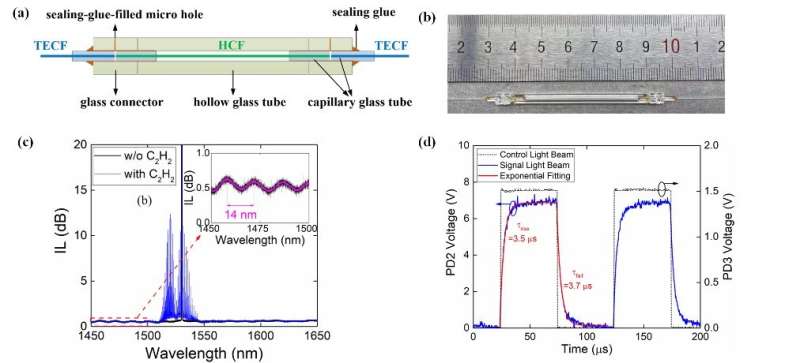Schematic diagram (a) and photo (b) of the fabricated gas-filled hollow-core fiber phase modulator. (c) Measured loss spectrum and (d) transient response of the phase modulator. Credit: Opto-Electronic Advances (2022). DOI: 10.29026/oea.2023.220085
Optical phase modulators are key components in optical communication, sensing, and signal processing systems. All-optical modulators, which modulate the phase or intensity of a light signal by a control light beam, have attracted much research interest. The phase of the signal beam is controlled by the control light beam rather than an electronical signal, which avoids electro-optical conversion in the optical link and makes it possible to break through the "electronic bottleneck" in principle.
The reported all-optical phase modulators are mainly based on 2D-material-coated optical waveguides. The signal light beam is modulated by the control beam through the interaction between the waveguide evanescent field and the 2D materials, including Kerr nonlinear effect and photo-thermal effect.
Kerr effect enables fast modulation but the attainable phase modulation is small limited by the optical power density of evanescent field and the nonlinear coefficient of 2D material. Longer interaction length contributes to a higher phase modulation, but also leads to increased loss. Photo-thermal effect enables larger phase modulation over π.
However, these phase modulators typically have high insertion loss and narrow wavelength band, limited by the absorption and imperfect deposition of low-dimensional materials, and long response time of several milliseconds due to heat conduction process. Although a lot of low-dimensional materials have been studied, there is still a big gap from practical usage. Developing novel all-optical phase modulators with low loss, broad wavelength band, fast response is essential to promote the development of all-optical technology.
The authors of this article in Opto-Electronic Advances discuss a broadband all-fiber optical phase modulator based on the light-gas interaction in a hollow-core fiber (HCF). In the HCF, most of the optical mode power propagates in the hollow core, which is free from absorption of the solid fiber materials. This enables extremely broadband low-loss transmission, from the ultraviolet to the mid-infrared, apart from a few narrow resonant loss bands. The HCF can confine gas phase material, a high intensity control beam and a signal beam simultaneously in the hollow core, providing an ideal platform for strong light-gas interaction over a long interaction length.
An all-optical phase modulator with insertion loss about 0.6 dB within C+L band and half-wave power about 289 mW at 100 kHz is fabricated. It has response time at μs scale, which is 2–3 orders better than the 2D-material-coated microfiber-based all-optical modulators. Due to the intrinsic limitation of the thermal conduction process, it is quite challenging to achieve modulation bandwidth over 1 MHz using this method.
It may have promising applications in fiber optic interferometer-based phase demodulation systems in particular for harsh environment and remote applications, as well as for all-fiber actively Q-switched lasers, which do not require very high modulation bandwidth. The broad transmission bands of the state-of-the-art HCFs in combination with the many available gas species would also allow the development of all-optical modulators from ultraviolet to mid-infrared, which are quite challenging to realize with solid state materials.
More information: Shoulin Jiang et al, Broadband all-fiber optical phase modulator based on photo-thermal effect in a gas-filled hollow-core fiber, Opto-Electronic Advances (2022). DOI: 10.29026/oea.2023.220085
Provided by Compuscript Ltd
























